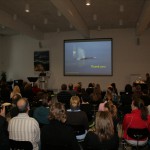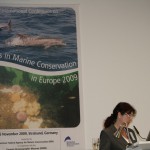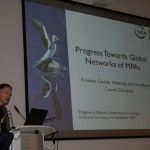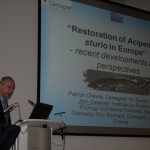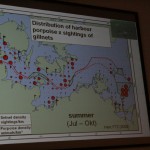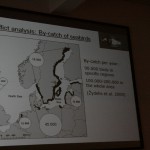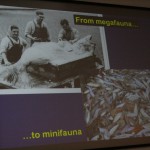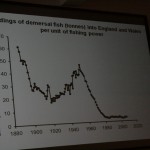„Postępy w ochronie przyrody morza w Europie w 2009 roku”. to tytuł konferencji zorganizowanej przez Niemiecką Agencję Ochrony Przyrody (BfN) i Niemieckie Muzeum Morskie (DMM). Odbyła się ona w dniach 2-6 listopada w Stralsundzie w budynku słynnego już, choć nowego OZEANEUM.
Bardzo bogaty i ciekawy program spotkania zgromadził ok. 150 uczestników z różnych krajów, nie tyko europejskich. Przedstawiano różne aspekty ochrony morskiej przyrody. Swój punkt widzenia przedstawiali reprezentanci placówek naukowych, instytucji zarządzających morzem i jego zasobami, firm eksploatujących morze, a także członkowie różnych organizacji pozarządowych (Program).
Tłem dla wielu omówień i wniosków była niedawno przyjęta przez Unię Europejską Ramowa Dyrektywa dot. Strategii Morskiej i wynikające z niej obowiązki państw członkowskich, Dyrektywy – Siedliskowa i Ptasia, nowa Wspólnotowa Polityka Rybacka a także, w wymiarze regionalnym, dotyczącym naszego morza, Bałtycki Plan Działania Komisji Helsińskiej i podobne inicjatywy w zakresie ochrony środowiska na Morzu Północnym i Pn. Atlantyku, podejmowane przez sygnatariuszy Konwencji OSPAR.
Uwidaczniała się asymetria osiąganych efektów działania na rzecz ochrony przyrody morza różnych krajów. Wiodąca rola przypada na razie społeczeństwom krajów najbogatszych. W nich robi się najwięcej i najbardziej poważnie traktuje się międzynarodowe zobowiązania.
Była to już druga konferencja tego typu, a kolejną zapowiedziano na 2012 rok. Cykliczność takich spotkań, a także liczne i kompetentne uczestnictwo, nadaje ochronie przyrody morza wysoką rangę, co uwidacznia się rosnącą pro-ekologiczną świadomością wielu europejskich społeczności.
Abstrakty i prezentacje referatów zostaną wg organizatorów niedługo opublikowane.
KES
(kliknij na miniaturki, aby powiększyć)
PROGRAM
Programme 2nd International Conference on: “Progress in Marine Conservation in Europe 2009”
Status of European and other MPA Networks
Opening speech by the president of the German Federal Agency for Nature onservation – Beate Jessel, BfN, Germany
Welcome address by the German Federal Ministry for the Environment, Nature Conservation and Nuclear Safety – Rudolf Ley, BMU, Germany
Welcome by the director of the German Oceanographic Museum,Harald Benke, DMM, Germany
“Status of the Marine Protected Area networks of HELCOM and OSPAR with regard to the 2010 targets (Bremen Conference)” – Anne-Christine Brusendorff, Helsinki Commission, Finland & Henning von Nordheim, OSPAR-MPA-Group, Germany
“Halting the loss of marine biodiversity by 2010: Progress under the Biodiversity Action Plan” Fotios Papoulias & Michael O’Briain, European Commission, Brussels
“Current status of the Habitats Directive marine Special Areas of Conservation (SACs) network” Otars Opermanis & Douglas Evans, European Topic Centre on Biological Diversity, Paris
“Developing a network of Marine Protected Areas in the Mediterranean High Seas“
Daniel Cebrian, Regional Activity Centre for Specially Protected Areas, Tunisia
“Pelagos Sanctuary: A High Seas MPA for the conservation of Marine Mammals in the Mediterranean” Giuseppe Notarbartolo di Sciara, Tethys Research Institute, Italy
“The Strategic Action Plan for the Black Sea Biodiversity and Landscape Conservation Protocol” Violeta Velikova, Black Sea Commission, Turkey
“New Zealand’s Marine Protected Areas policy and its current implementation”
Danica Devery-Smith, Department of Conservation, New Zealand
“The French MPA network in Europe and the new Agency for Marine Protected Areas”
François Gauthiez, French MPA Agency, France
“Progress towards the development of a global network of MPAs” Kristina Gjerde, International Union for Conservation of Nature, Poland & Henning von Nordheim, BfN, Germany
Wednesday, 04 November 2009
Management of Anthropogenic Impacts on the Marine Environment
“The global human impact on marine ecosystems”
Benjamin S. Halpern, National Center for Ecological Analysis and Synthesis, USA
“Compliance strategy to protect the Great Barrier Reef Marine Park”
Mick Bishop, Great Barrier Reef Marine Park Authority, Australia
“Historical decline of demersal fisheries and future management implications in UK waters” Ruth Thurstan, University of York, United Kingdom
“Marine Protected Areas to safeguard fisheries in European temperate waters”
Callum Roberts, University of York, United Kingdom
“Environmentally Sound Fisheries Management in Marine Protected Areas (EMPAS): Management proposals” Christian Pusch, BfN, Germany
“Potential and threats of restoration of oyster reefs (Ostrea edulis) in European Seas” Aad Small, Institute for Marine Resources and Ecosystem Studies, The Netherlands
Thursday, 05 November 2009
New Marine Management Measures and Tools
“Restoration of the sturgeon Acipenser sturio in Europe”
Patrick Chèvre, Cemagref, France & Jörn Geßner, Institute for Freshwater Ecology and Inland Fisheries, Germany
“Mitigation measures for marine sand & gravel extraction”
Gerry Sutton, University College Cork, Ireland
“Lobster protection in Marine Protected Areas”
Alf Ring Kleiven, University of Tromsø, Norway
“Identification of Areas To Be Avoided by shipping in Particularly Sensitive Sea Areas (PSSA)” Matthew Gianni, Deep Sea Conservation Coalition, The Netherlands
“Methods to reduce noise from pile driving for off-shore installations“
Tanja Grießmann, Leibniz University of Hanover, Germany
“Drilled Concrete Monopile” Edwin van de Brug, Ballast Nedam Offshore, The Netherlands
“New methods for military munitions clearance in the marine environment”
Sven Koschinski, Consultant, Germany
“Marine noise pollution in the North Sea”
Karsten Brensing, Whale and Dolphin Conservation Society, Germany
“From seabed mapping to fish movement tracking: MPA designing by using multiple conservation features in the Azores“ Pedro Afonso, University of the Azores, Portugal
“Changes of the distribution range of European fish species according to the current climate change scenarios” Kristin Kaschner, University of Freiburg, Germany
“European and national legislation frameworks for the establishment of management plans in Marine Protected Areas” Ronan Long, University of Ireland, Ireland
“New Book: Fishery management in the EU“
Daniel Owen, Fenners Chambers, United Kingdom
“Google Earth – a new tool to illustrate global marine conservation“
Jen Ashworth, International Union for Conservation of Nature, United Kingdom
Film “Who owns the sea?”
Sarah Zierul, Science Journalist, Germany
Friday, 06 November 2009
First Steps towards Meeting the Biodiversity targets of the European Marine Strategy Framework Directive (MSFD)
“Implementing the MSFD in Germany – Status quo – Musts – Tools – Outlook!”
Fritz Holzwarth, BMU, Germany
“Requirements from the NGO’s viewpoint regarding achievement of a „good environmental status” in European Seas” Saskia Richartz, Greenpeace, Brussels & Stephan Lutter, World Wide Fund for Nature, Germany
“Good Environmental Status Indicators for benthos within the MSFD: taking advantage from the Water Framework Directive” Ángel Borja, AZTI-Tecnalia, Spain
“Good Environmental Status Indicators for sea turtles: How to protect sea turtles under the Habitats Directive and MSFD” Thomas Dellinger, University of Madeira, Portugal
The 2nd International Conference on: “Progress in Marine Conservation in Europe 2009” is hosted by the German Federal Agency for Nature Conservation (BfN) in cooperation with the German Oceanographic Museum (DMM) and financed by the German Federal Ministry for the Environment, Nature Conservation and Nuclear
Safety (BMU).

